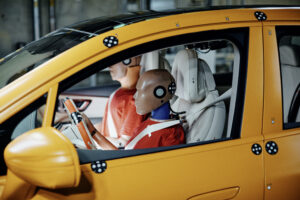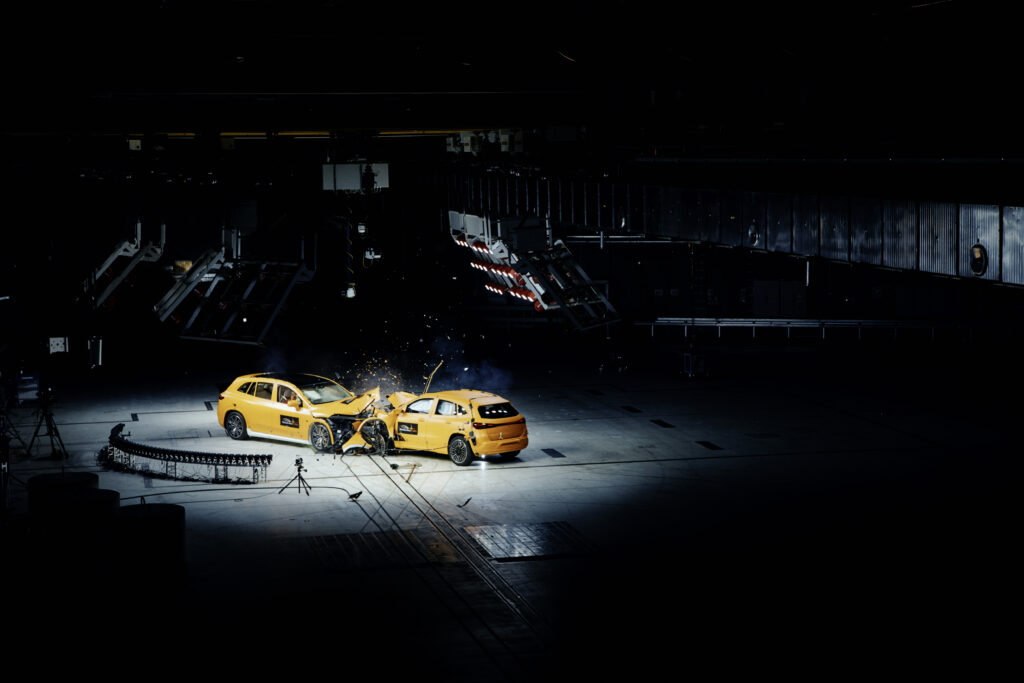
Mercedes-Benz crashes 2 of its EVs to demonstrate safety, battery protection
By onTechnology
Mercedes-Benz says it has performed the world’s first public collision between two fully electric vehicles (EVs) to prove its designs keep occupants safe and batteries protected in such scenarios.
In a video posted to YouTube, the automaker detailed how it pulled two new EVs from its production facility to study the results of a planned head-on crash with a speed of 56 km/h (35 mph) and a 50% overlap.
The test included a Mercedes-Benz EQA 300 4MATIC and a Mercedes-Benz EQS 450 4MATIC.
According to the OEM, the test demonstrated that both vehicles could effectively absorb the energy of the crash by deforming and, as a result, keep passengers safe and the battery intact. The doors also remained operational, allowing passengers to exit freely or be rescued, Mercedes said.
It added that the high-voltage systems on both SUVs switched off automatically during the collision as it is designed to do during a serious collision. Mercedes said its EVs were developed with a multi-stage, high-voltage protection concept that includes eight elements to protect the battery and all components with voltage higher than 60 volts.
“Safety is part of Mercedes-Benz’s DNA and one of our core commitments to all road users. And to us, protecting human lives is not a question of drive system. The recent crash test involving two fully electric vehicles demonstrates this. It proves that all our vehicles have an equally high level of safety, no matter what technology drives them,” said Markus Schäfer, Mercedes’ chief technology officer and a member of its member of the Board of Management. “We are working hard to achieve our vision of accident-free driving… We don’t just want zero traffic fatalities by 2050 and a halving in the number of traffic fatalities and serious injuries by 2030 compared to 2020. Our goal by 2050 is zero accidents involving a Mercedes-Benz vehicle.”
Mercedes engineers interviewed for the video said the test, which was preceded by simulations, was meant to demonstrate the impacts of a real-world crash. The SUVs were then painted orange before measuring instruments and crash test dummies were put in place to determine the collision’s impact.
Hanna Paul, Mercedes’ crash test dummy engineer, said up to 150 sensors were used to evaluate the vehicles’ safety.
“The sensors measure different forces, different acceleration, and compressions,” Paul said. “Those measurements are directly linked to possibilities of injuries. One of the most important things which has to be prepared is that the dummy is working properly. The kinematics are correct, the sensors are measuring properly. And then we have to make sure that the dummies are positioned correctly in the car.”
Mercedes said each of the vehicles carried two dummies, with a total of three females and one male. Its sensors demonstrated that the crash would have resulted in a low risk of serious or fatal injury.
“All safety equipment, such as airbags and belt tensioners with belt force limiters, worked as intended,” the OEM said in a press release. “The crash test thus confirmed the results that the engineers had previously calculated in numerous computer simulations. Real-life vehicle testing always also serves as a final comparison with the simulations.”

The video offered a glimpse into engineers ensuring all dummies are properly in place, with sensors affixed into the correct position, before the crash test begins. It then transitions to a slow-motion scene where two SUVs are colliding head-on, with airbags in both vehicles deploying and the cars’ front ends smashing to pieces.
“It’s important that, especially with electric vehicles, that there is no damage to the battery and to the high voltage components,” Julia Hinners, Mercedes’ passive safety engineer. “Both vehicles look completely destroyed at first and the front looks severely damaged. This is part of the protection concept for the occupants. The front of the vehicles deform as designed to effectively absorb energy and reduce the forces to the occupants.”
Paul Dick, Mercedes’ director of public safety, said he was pleased with the results of the test, as it demonstrated that the vehicle design was effective at protecting occupants.
“This crash test involving two electric vehicles, which we have shared publicly for the first time in this way, underlines our commitment to building the world’s safest vehicles. The four female and male dummies complied with the biomechanical limits in this extremely severe crash. This demonstrates our expertise in electric vehicle safety.”
Images
Featured images and video courtesy of Mercedes-Benz
